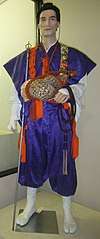Shugendō
Shugendō (修験道, literally "the way of shugen, or gen-practice"[1]) is a highly syncretic religion that originated in Heian Japan. Practitioners are called Shugenja (修験者) or Yamabushi (山伏, literally "mountain prostrate").

.jpg)
History
Shugendō evolved during the seventh century from an amalgamation of beliefs, philosophies, doctrines and ritual systems drawn from local folk-religious practices, pre-Buddhist mountain worship, Shinto, Taoism and Vajrayana.[2]
The seventh-century ascetic and mystic En no Gyōja is widely considered as the patriarch of Shugendō, having first organized Shugendō as a doctrine. Shugendō literally means "the path of training and testing" or "the way to spiritual power through discipline."[3][4]
The Meiji government, which erected a barrier between Shinto and Buddhism, ruled that Shugendō was unacceptable because of its amalgamation of the two religions, and officially forbade it in 1872. With the advent of religious freedom in Japan after World War II, Shugendō was revived.[1]
In modern times, Shugendō is practiced mainly through Tendai and Shingon temples. Some temples include Kimpusen-ji in Yoshino (Tendai), Ideha Shrine in the Three Mountains of Dewa and Daigo-ji in Kyoto (Shingon).
Shugendō practitioners are said to be descendants of the Kōya Hijiri monks of the eighth and ninth centuries.[5]
See also
References
- Catherine Cornille (2013). The Wiley-Blackwell Companion to Inter-Religious Dialogue. John Wiley & Sons. ISBN 9781118529942.
- Kornicki, P.F.; McMullen, I. J. (1996). Religion in Japan: Arrows to Heaven and Earth (Reprint ed.). Cambridge: Cambridge University Press. pp. 13-. ISBN 9780521550284. Retrieved 11 March 2017.
- Picken, Stuart D.B. (1994). Essentials of Shinto: An Analytical Guide to Principal Teachings. Westport, Connecticut: Greenwood Press. p. 99. ISBN 0313264317.
- Blacker, Carmen (2000). "16: Initiation in the Shugendō: the Passage Through the Ten States of Existence". Collected Writings of Carmen Blacker. Richmond, Surrey: Japan Library. pp. 186–199. ISBN 9781873410929.
- Blacker, Carmen (1999). The Catalpa Bow: A Study of Shamanistic Practices in Japan (3rd ed.). Richmond: Japan Library. pp. 165–167. ISBN 1873410859.
Further reading
- Faure, Bernard; Moerman, Max; Sekimori, Gaynor (2011). Shugendō: The History and Culture of a Japanese Religion. Kyoto: Ecole française d'Extrême-Orient, centre de Kyoto. ISBN 9782855391236.
- Gill, Andrea K. (2012). "Shugendō: Pilgrimage and Ritual in a Japanese Folk Religion". Pursuit - The Journal of Undergraduate Research at the University of Tennessee. 3 (2): 49–65. ISSN 2330-4715. Retrieved 11 October 2017.
- Hitoshi, Miyake; Sekimori, Gaynor (2005). The Mandala of the Mountain: Shugendō and Folk Religion (1st ed.). Tokyo: Keio University Press. ISBN 9784766411287.
- Miyake, Hitoshi (1989). "Religious Rituals in Shugendo: A Summary". Japanese Journal of Religious Studies. 16 (2/3): 101–116. doi:10.18874/jjrs.16.2-3.1989.101-116. JSTOR 30234003.
External links
- A Look at Japanese Ascetic Practice
- Head Temple Takao-san Yakuo-in Central Shugendo Training Center in Kanto
- 天台寺門宗|修験道
- Shugen: The Autumn Peak of Haguro Shugendo
- Mount Fuji and Shugendo
- Shugendo article in Buddhism & Shintoism in Japan: A-to-Z Photo Dictionary of Japanese Religious Sculpture & Art
- Yamabushi practice training | Dewa Sanzan
- Shugendo - History of Japan Database